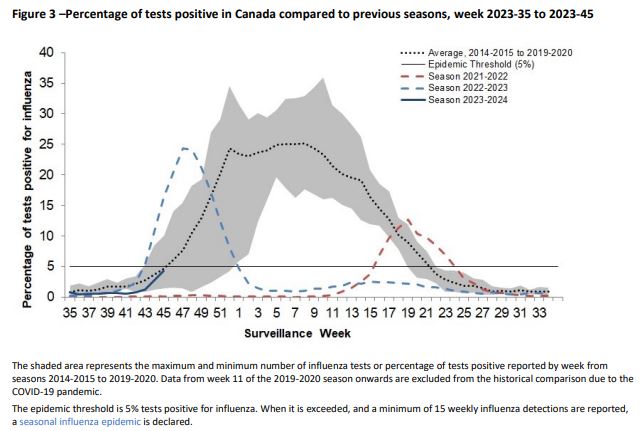As flu season sweeps in with its familiar symptoms of coughs and sneezes across Canada, a glimmer of relief emerges: health experts say that while cases are on the rise, the increase is notably below average compared with preceding years.

Last year at this time, the Public Health Agency of Canada (PHAC) said influenza activity had already crossed the seasonal threshold, indicating a “start of an influenza epidemic.” However, this season, PHAC says that while influenza activity is increasing, overall activity remains low and below seasonal threshold levels.
“So far, it looks as if this season is going to be one of concern, but certainly nowhere near as bad as obviously the late onset that we had in 2021 and 2022,” said Dr. Brian Conway, medical director of the Vancouver Infectious Disease Centre.
“As the restrictions were lifted … last year we had a significant number of cases by now, and then it went up from there. And this is below average, below what we had last year.”
Flu season in Canada typically falls in the autumn and winter months, with activity often starting to increase in late October. The peak of flu season in Canada tends to occur between December and February, although the timing can vary every year.
According to the latest report, which includes PHAC’s flu numbers from Aug. 27 to Nov. 11, there have been 3,065 reported cases of influenza across Canada, 95 per cent of which were from influenza A. There also have been 184 flu-associated hospitalizations, 21 admissions to the intensive care unit (ICU) and six deaths, according to PHAC.

Adults aged 65 years of age and older accounted for 51 per cent of reported hospitalizations. And 97 per cent of the hospitalizations were associated with influenza A.
Last year’s flu season saw much higher numbers by this time.
From Aug. 28 to Nov. 12, 2022, there were 8,273 influenza cases reported, 99 per cent of which were influenza A. There were 394 flu-related hospitalizations by this time last year, 32 ICU admissions and nine influenza-associated deaths.
PHAC reported that during this time period last year, the highest cumulative hospitalization rates were among children under the age of five and adults 65 years of age and older.
At the end of the 2022-23 flu season, PHAC said there were more than 72,000 reported and confirmed cases of influenza and more than 6,000 hospitalizations.
While the current influenza numbers are lower than those of the previous year, Dr. Mark Loeb, an infectious diseases specialist and medical microbiologist at McMaster University, cautions that the virus is inherently unpredictable.
“Across the country, there is sporadic activity and some localized activity, but it’s not widespread yet,” he said. “But it is still too early to make predictions; we don’t know how much it will peak.”
'We shouldn't be complacent'
It may be too early to predict how this flu season will play out, but Conway believes numbers may be lower this year due to the prior influence of COVID-19 on the spread of the virus.
“Last year was the first year in which we’d been out of confinement for a length of time before the onset of the respiratory virus season,” Conway said. “So, it having been more exuberant was potentially expected.”
The 2022-23 flu season in Canada marked a notable resurgence, bouncing back after a couple of years of unusually low numbers during the COVID-19 pandemic. Young children were particularly affected.

“It’s off to a slower start than last year. But … we shouldn’t be complacent. It doesn’t mean you don’t need your shots. It doesn’t mean you don’t need to stay home if you’re sick,” Conway warned.
To maintain low influenza numbers in Canada, Loeb and Conway emphasized that the most effective measure is to prioritize getting a flu vaccination, particularly for those who are at high risk.
PHAC has not provided data on the number of Canadians who have received their flu shot. However, Conway mentioned that, based on observations, there has been an enthusiastic beginning to flu vaccinations.
“I think people are more fatigued of COVID vaccines than any other vaccines,” he said, noting that in British Columbia, he has observed a higher uptake of flu shots than COVID-19 vaccines.

This year’s flu shot is designed to combat four strains of the flu: influenza A (H1N1 and H3N2) and influenza B (B/Victoria and B/Yamagata). Currently, PHAC reports that a majority of flu cases are attributed to H1N1.
Conway warned that people aged 65 years and older are particularly vulnerable to influenza A, stressing the importance of this group getting the flu shot.
“If they get influenza A, they’re at risk of hospitalization and severe outcomes from influenza itself,” he said. “Within the week after they get influenza A, they have a sixfold higher rate of heart attacks than those who don’t have influenza A. And six months later, it may be that half of them haven’t totally recovered to their baseline.”
Canadians should not only prioritize getting their seasonal flu shot but Conway said they should also stay home when unwell, practise thorough handwashing and wear a mask whenever possible.
“Run, don’t walk off. Go get your vaccine,” he said. “You can get a flu shot. You can get a COVID shot, one in each arm or both in the same arm.”
- Posters promoting ‘Steal From Loblaws Day’ are circulating. How did we get here?
- As Canada’s tax deadline nears, what happens if you don’t file your return?
- Video shows Ontario police sharing Trudeau’s location with protester, investigation launched
- Solar eclipse eye damage: More than 160 cases reported in Ontario, Quebec




Comments